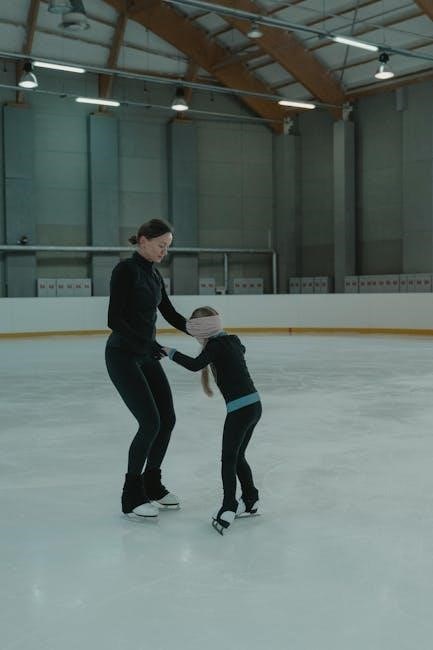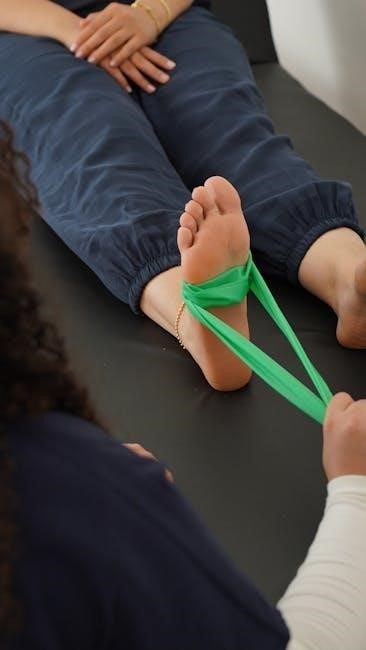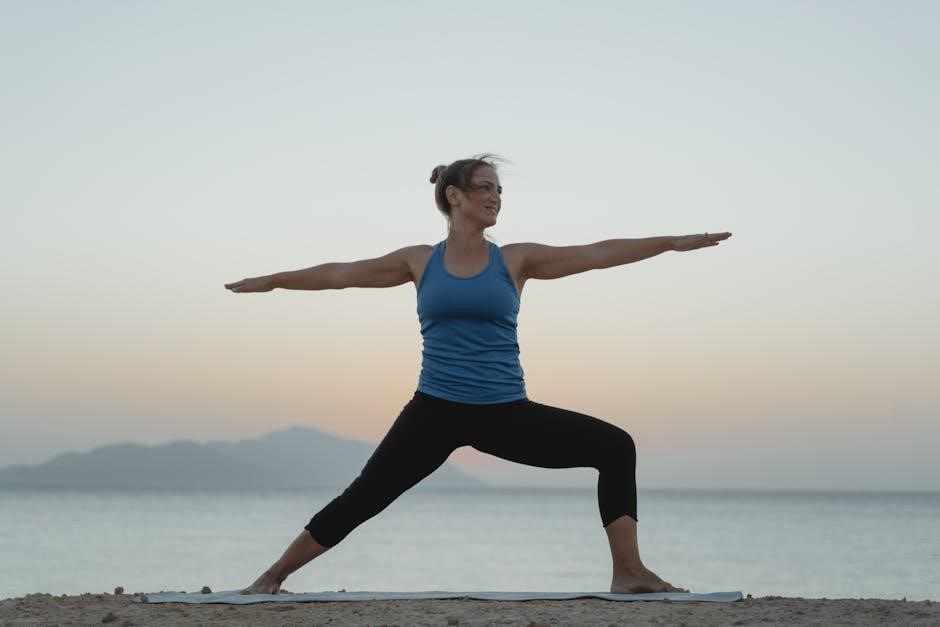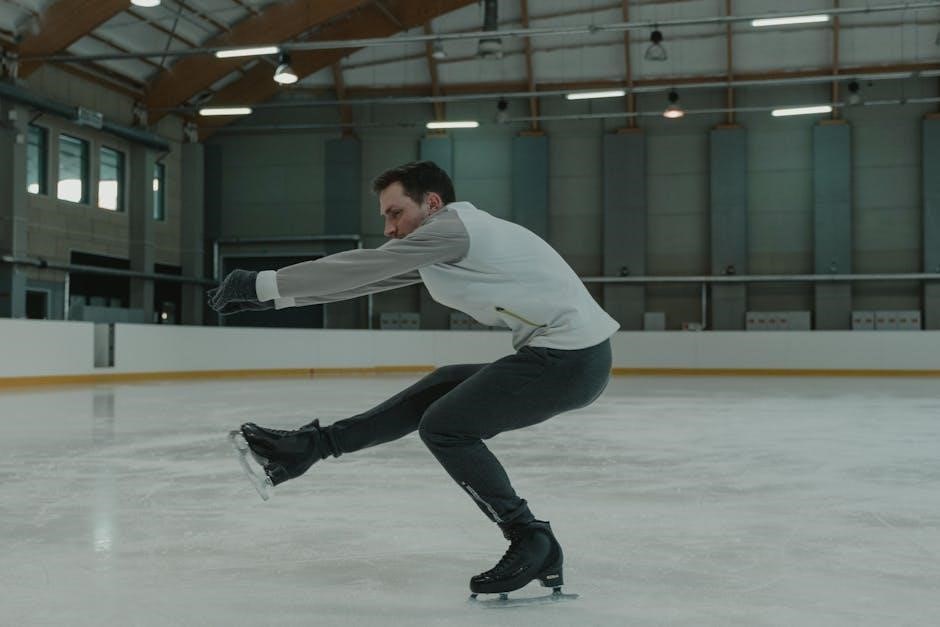An inguinal hernia occurs when tissue, often part of the intestine, protrudes through a weak spot in the abdominal wall near the groin. It is the most common type of hernia, affecting both men and women. Symptoms include pain, discomfort, and a noticeable bulge, especially when coughing or lifting heavy objects. While exercises play a role in managing and preventing hernias, medical supervision is essential to avoid complications. Early intervention and appropriate physical activities can significantly improve outcomes for individuals with inguinal hernias.
1.1 Definition and Overview
An inguinal hernia occurs when intestinal tissue protrudes through a weakened area in the abdominal wall near the groin. Common in both genders, it often presents with pain, a visible bulge, and discomfort during physical activities. The inguinal canal, a natural passageway for blood vessels and nerves, is where this protrusion typically happens. While some hernias are asymptomatic and may not require immediate intervention, they can lead to complications like strangulation if untreated. Understanding this condition is crucial for effective management and prevention strategies.
1.2 Prevalence and Demographics
Inguinal hernias are more common in men than women, with a prevalence of approximately 1-3% in adults. They often occur in individuals aged 40 and above, though congenital cases can affect newborns. Men are 8-10 times more likely to develop inguinal hernias due to anatomical differences. Risk factors include family history, obesity, and occupations involving heavy lifting. While hernias can occur at any age, most cases are diagnosed in adults, emphasizing the importance of early detection and preventive measures.

Causes and Risk Factors of Inguinal Hernias
Inguinal hernias arise from weak abdominal muscles, often congenital, and are exacerbated by activities like heavy lifting or straining, which increase intra-abdominal pressure.
2.1 Weak Abdominal Muscles
Weak abdominal muscles are a primary cause of inguinal hernias, as they create vulnerable areas in the abdominal wall. This weakness can be congenital or develop over time due to lack of exercise, aging, or repetitive strain. When abdominal muscles are weak, they fail to provide adequate support, allowing internal tissues to protrude through the inguinal canal. Strengthening these muscles through targeted exercises is essential for managing and preventing hernias, as it helps restore abdominal stability and reduce the risk of further complications.
2.2 Straining and Heavy Lifting
Straining and heavy lifting are significant risk factors for inguinal hernias. These activities increase intra-abdominal pressure, which can weaken abdominal muscles and lead to hernia development. Proper lifting techniques and avoiding sudden strain are crucial for prevention. Strengthening core muscles through exercises can reduce the risk, while maintaining a healthy weight further minimizes strain on the abdominal wall. Addressing these factors is essential for managing and preventing hernias effectively.
2.4 Obesity and Poor Posture
Obesity increases intra-abdominal pressure, making the abdominal wall more susceptible to hernias. Poor posture further strains the muscles, exacerbating the risk. Weight management through diet and exercise is crucial to reduce pressure on the abdominal wall. Strengthening core muscles and improving posture can help alleviate strain and prevent hernia development. Addressing these factors is vital for overall abdominal health and hernia prevention.

Importance of Exercises in Hernia Management
Exercises strengthen abdominal muscles, reducing pressure on the inguinal canal and supporting hernia repair. Regular physical activity improves core stability, aiding in recovery and preventing recurrence.
3.1 Strengthening Core and Pelvic Floor Muscles
Strengthening the core and pelvic floor muscles is essential for managing inguinal hernias. Exercises like pelvic floor contractions and transverse abdominal activations help stabilize the abdominal wall, reducing pressure on the inguinal canal. Gentle stretches and low-impact movements improve muscle tone, supporting the hernia and preventing further protrusion. Regular practice enhances posture, reduces discomfort, and aids in recovery, especially post-surgery. Consistency is key to rebuilding strength and promoting long-term stability in the affected area.
3.2 Reducing Pressure on the Inguinal Canal
Reducing pressure on the inguinal canal is crucial for managing hernias. Gentle stretching exercises, such as hamstring stretches and pelvic tilts, help alleviate strain. Avoiding heavy lifting and adopting a supportive posture can minimize discomfort. Low-impact activities like walking and swimming are recommended to maintain mobility without increasing intra-abdominal pressure. These practices, combined with core-strengthening exercises, help reduce the risk of hernia worsening and promote overall abdominal stability.
3.3 Preventing Hernia Recurrence
Preventing hernia recurrence involves a combination of targeted exercises and lifestyle adjustments. Strengthening the transverse abdominal muscles through exercises like pelvic floor activations and deep breathing can enhance abdominal wall stability. Gradually incorporating core-strengthening activities and avoiding heavy lifting are essential. Post-surgery, adherence to rehabilitation programs ensures proper healing. Regular monitoring and maintaining a healthy weight also play significant roles in minimizing the risk of recurrence, promoting long-term recovery and reducing the likelihood of future hernias.

Safe Exercises for Inguinal Hernias
Safe exercises for inguinal hernias focus on strengthening abdominal muscles and improving posture without strain. Gentle stretches, light aerobic activities, and core-strengthening techniques are recommended to reduce discomfort and support recovery.
4.1 Gentle Stretching Exercises
Gentle stretching exercises are crucial for managing inguinal hernias. These exercises aim to improve flexibility and reduce tension in the groin and abdominal areas. Techniques such as hamstring stretches, hip rotations, and pelvic tilts are recommended. It is important to perform these stretches slowly and avoid any movements that cause discomfort or strain. Regular practice can help alleviate symptoms and support the healing process without putting additional pressure on the hernia.
4.2 Low-Impact Aerobic Activities
Low-impact aerobic activities, such as walking, swimming, or cycling, are beneficial for individuals with inguinal hernias. These exercises improve circulation, strengthen muscles, and enhance overall fitness without putting excessive strain on the hernia. Activities like brisk walking for 30 minutes daily or swimming laps can help maintain mobility and reduce discomfort. It is important to avoid high-impact movements that may worsen the condition. Always consult a healthcare provider before starting any new exercise routine to ensure safety and effectiveness.
4.3 Core Strengthening Techniques
Core strengthening techniques focus on enhancing the stability and endurance of abdominal muscles, which are crucial for supporting the inguinal canal. Gentle exercises like pelvic tilts, bridges, and controlled breathing can improve core strength without exerting excessive pressure. Techniques such as the “draw-in” maneuver, where the abdomen is pulled inward toward the spine, are particularly effective. Regular practice of these exercises helps stabilize the hernia and reduces the risk of further strain or complications. Always perform these under professional guidance to ensure safety and effectiveness.

Post-Surgery Rehabilitation Exercises
Post-surgery rehabilitation involves gentle exercises to restore strength and mobility. Light stretching, core-strengthening techniques, and gradual movement are essential for a safe and effective recovery process.
5.1 Early Mobilization Techniques
Early mobilization after inguinal hernia surgery focuses on gentle movements to prevent stiffness and promote healing. Techniques include short walks, light stretching, and pelvic tilts. These exercises help restore blood flow and muscle function without straining the repair site. Patients are encouraged to avoid heavy lifting or bending and to prioritize low-impact activities. Proper breathing exercises and gradual progression of movements are also recommended to ensure a safe and effective recovery process.
5.2 Gradual Strengthening Programs
Gradual strengthening programs after hernia surgery focus on rebuilding core and pelvic floor muscles. Patients start with gentle exercises like pelvic tilts, bridges, and deep breathing. Progression includes light resistance training and controlled movements to avoid strain. Strengthening the transverse abdominal muscles helps stabilize the inguinal canal. These programs aim to restore functional strength while minimizing the risk of hernia recurrence. Supervision by a healthcare provider ensures a safe and effective recovery process.

Preventive Exercises for Hernia
Preventive exercises focus on strengthening pelvic floor and core muscles to reduce hernia risk. Techniques include Kegel exercises, planks, and gentle stretches to improve abdominal stability and posture.
6.1 Pelvic Floor Exercises
Pelvic floor exercises, such as Kegels, strengthen the muscles that support the abdomen and reduce hernia risk. To perform Kegels, squeeze the muscles as if stopping urine flow, holding for 5-10 seconds. Repeat 10-15 times daily. These exercises improve core stability and posture, essential for preventing hernias. Regular practice can also enhance overall pelvic health and reduce pressure on the inguinal canal, making them a vital part of hernia prevention and management strategies.
6.2 Transverse Abdominal Muscle Activation
Transverse abdominal muscle activation strengthens the deepest abdominal layer, crucial for spinal and pelvic stability. Engage by drawing the belly button toward the spine, holding 5-10 seconds. This exercise improves core stability, reducing pressure on the inguinal canal and aiding hernia prevention. Regular practice enhances posture, reduces strain, and supports overall abdominal health, making it an essential component of hernia management and preventive routines.

Diet and Lifestyle Modifications
Maintaining a healthy weight reduces abdominal pressure, lowering hernia risk. Avoid heavy lifting and adopt a high-fiber diet to prevent straining during bowel movements, supporting hernia management.
7.1 Weight Management
Weight management is crucial for individuals with inguinal hernias, as excess body fat increases abdominal pressure, potentially worsening the condition. A balanced diet rich in fruits, vegetables, and whole grains helps maintain a healthy weight. Portion control and regular physical activity, such as walking or swimming, are recommended. Avoiding obesity reduces the strain on the abdominal wall, minimizing the risk of hernia progression or recurrence. Consulting a healthcare provider for personalized advice ensures safe and effective weight loss.
7;2 Avoiding Heavy Lifting
Avoiding heavy lifting is essential to prevent strain on the abdominal muscles and inguinal canal. Lifting heavy objects can increase intra-abdominal pressure, potentially worsening a hernia or causing recurrence. Proper lifting techniques, using leg muscles instead of the back, can reduce risk. If heavy lifting is unavoidable, wearing supportive gear like a hernia belt may help. Consulting with a healthcare provider ensures individuals adopt safe practices tailored to their condition, promoting long-term hernia management and overall abdominal health.

Monitoring and Progress Tracking
Regular monitoring of hernia symptoms and exercise progress is crucial. Tracking improvements and adjusting routines help maintain abdominal health and prevent recurrence, ensuring safe and effective management.
8.1 Regular Check-Ups
Regular check-ups with a healthcare provider are essential for monitoring hernia symptoms and exercise progress. These visits help identify potential complications early and ensure exercises are effective without causing strain. Medical supervision allows for timely interventions and adjustments to routines. Check-ups also provide opportunities to address concerns and track overall abdominal health, ensuring safe and continued progress in managing the hernia. This approach supports long-term well-being and prevents recurrence, aligning with recommendations for walking and light stretching as part of daily routines.
8.2 Adjusting Exercise Routines
Adjusting exercise routines for inguinal hernias involves tailoring activities to individual progress and comfort levels. Starting with light stretching and walking, exercises can gradually intensify as strength improves. Core strengthening is beneficial but must be done cautiously to avoid strain. Consulting a physical therapist can help customize routines, ensuring they promote healing without exacerbating the hernia. Avoiding heavy lifting is crucial, focusing instead on low-impact aerobics and gentle strengthening. Listening to the body and modifying exercises as needed, along with tracking progress, allows for informed adjustments. Consistency and flexibility are key, balancing muscle challenge with injury prevention to support long-term well-being.

When to Seek Medical Attention
Consult a doctor if symptoms worsen or new pain occurs. Seek medical advice before starting exercises to prevent complications and ensure safe hernia management.
9.1 Symptoms of Hernia Worsening
Key symptoms indicating a worsening hernia include increased bulge size, persistent pain, and discomfort during physical activity. Redness or swelling around the hernia site may signal complications. If pain intensifies or the hernia becomes irreducible, seek immediate medical attention. These signs suggest potential strangulation or incarceration, which are medical emergencies requiring prompt intervention to prevent serious health risks.
9.2 Complications and Emergency Situations
Serious complications of inguinal hernias include strangulation, where blood flow to the trapped tissue is cut off, and incarceration, where the hernia cannot be pushed back. These conditions require immediate medical attention. Emergency situations may involve severe pain, nausea, vomiting, or a hard, tender bulge. If left untreated, these complications can lead to tissue death or life-threatening infections. Prompt surgical intervention is crucial in such cases to prevent further damage and ensure recovery.

